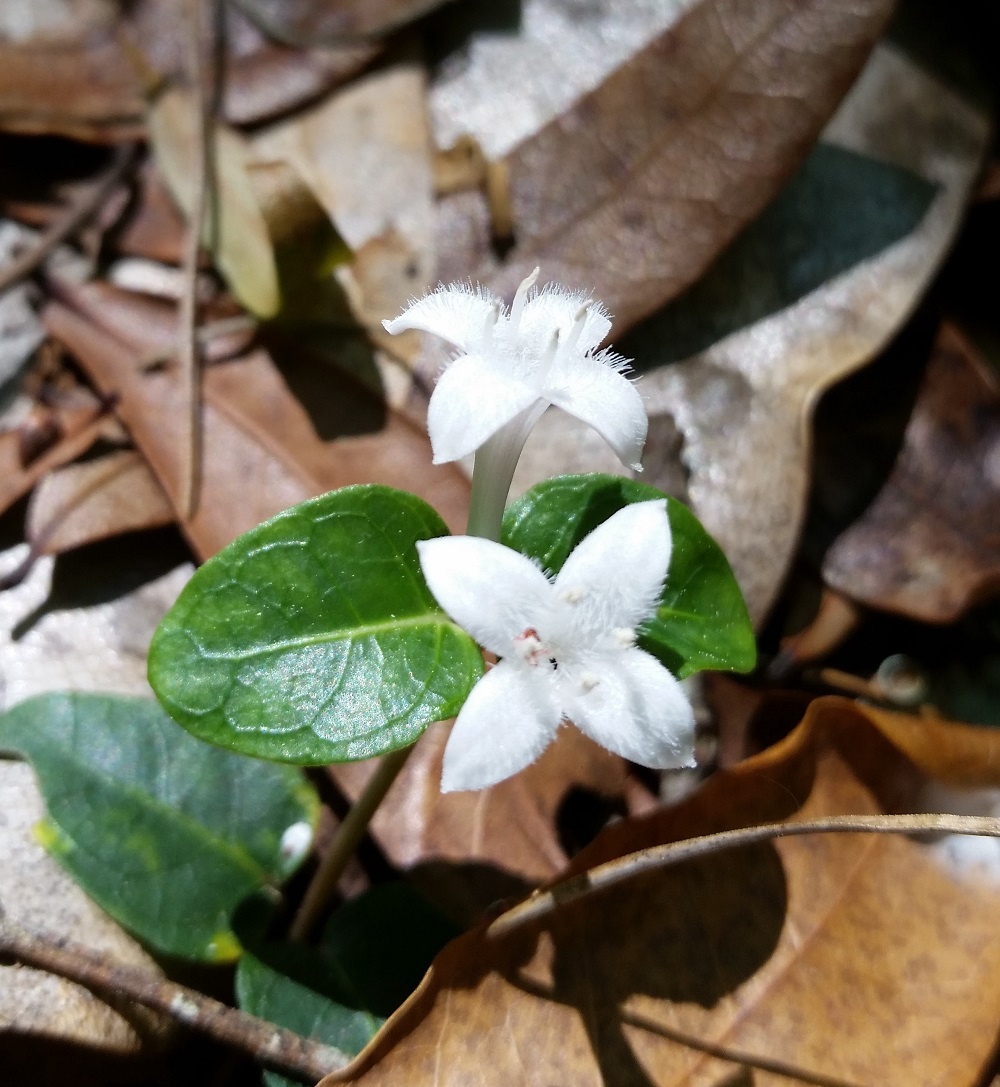Difference between revisions of "Mitchella repens"
(→Habitat) |
|||
| Line 30: | Line 30: | ||
==Ecology== | ==Ecology== | ||
===Habitat=== | ===Habitat=== | ||
| − | ''M. repens'' is found in deciduous and coniferous forests, streambanks, heath balds, maritime forests, rotten logs and hummocks, and in bottomlands or other wetland habitats. The plants in maritime forests are more robust than others and often have an ascending habit, the | + | ''M. repens'' has been found in mesic hardwoods, pinewoods, floodplains, streambanks, Beech-magnolia woods, live oak groves, bogs, and swamps.<ref name="FSU"> Florida State University Herbarium Database. URL: http://herbarium.bio.fsu.edu. Last accessed: June 2021. Collectors: Loran C. Anderson, K. Craddock Burks, Patricia Elliot, J. P. Gillespie, and R.K. Godfrey. States and counties: Florida: Jefferson, Levy, Leon, Liberty, and Wakulla.</ref> It is also found in disturbed areas including along fire breaks, railroads, and roadsides.<ref name="FSU"/> Associated species: ''Pinus strobus, Acer saccharum, A. rubrum, Betula lenta, Fraxinus americana, Quercus rubra, Fagus grandifolia, Acer pensylvanicum, Caulophyllum thalictroides, Athyrium angustum, Tiarella cordifolia'', and ''Polygonatum biflorum''.<ref name="BRU"> Brown University Herbarium accessed using Southeastern Regional Network of Expertise and Collections (SERNEC) data portal. URL: http://sernecportal.org/portal/collections/index.php Last accessed: June 2021. Collectors: Sophie Duncan, Andrew Pisaturo, and Timothy J. S. Whitfeld. States and Counties: Massachusetts: Berkshire.</ref> |
| − | stems sometimes 20-30 cm tall<ref name="weakley">Weakley, A.S. 2015. Flora of the southern and mid-atlantic states. Working Draft of 21 May 2015. University of North Carolina at Chapel Hill, Chapel Hill, North Carolina.</ref> <!--Natural communities, human-disturbed habitats, topography, hydrology, soils, light, fire regime requirements for removal of competition, etc.--> | + | |
| + | <!--''M. repens'' is found in deciduous and coniferous forests, streambanks, heath balds, maritime forests, rotten logs and hummocks, and in bottomlands or other wetland habitats. The plants in maritime forests are more robust than others and often have an ascending habit, the | ||
| + | stems sometimes 20-30 cm tall<ref name="weakley">Weakley, A.S. 2015. Flora of the southern and mid-atlantic states. Working Draft of 21 May 2015. University of North Carolina at Chapel Hill, Chapel Hill, North Carolina.</ref>--> <!--Natural communities, human-disturbed habitats, topography, hydrology, soils, light, fire regime requirements for removal of competition, etc.--> | ||
| + | |||
===Phenology=== <!--Timing off flowering, fruiting, seed dispersal, and environmental triggers. Cite PanFlora website if appropriate: http://www.gilnelson.com/PanFlora/ --> | ===Phenology=== <!--Timing off flowering, fruiting, seed dispersal, and environmental triggers. Cite PanFlora website if appropriate: http://www.gilnelson.com/PanFlora/ --> | ||
''M. repens'' is an evergreen, but flowers from May through July and flowers from June through July.<ref name="weakley">Weakley, A.S. 2015. Flora of the southern and mid-atlantic states. Working Draft of 21 May 2015. University of North Carolina at Chapel Hill, Chapel Hill, North Carolina.</ref> | ''M. repens'' is an evergreen, but flowers from May through July and flowers from June through July.<ref name="weakley">Weakley, A.S. 2015. Flora of the southern and mid-atlantic states. Working Draft of 21 May 2015. University of North Carolina at Chapel Hill, Chapel Hill, North Carolina.</ref> | ||
Revision as of 15:31, 9 June 2021
| Mitchella repens | |
|---|---|

| |
| Photo by Katelin Pearson | |
| Scientific classification | |
| Kingdom: | Plantae |
| Division: | Magnoliophyta - Flowering plants |
| Class: | Magnoliopsida – Dicotyledons |
| Order: | Rubiales |
| Family: | Rubiaceae |
| Genus: | Mitchella |
| Species: | D. repens |
| Binomial name | |
| Mitchella repens L. | |

| |
| Natural range of Mitchella repens from USDA NRCS Plants Database. | |
Common name: Partridge-berry[1]
Contents
Taxonomic notes
Synonyms: none.[1]
Varieties: none.[1]
Description
Distribution
M. repens ranges from Novia Scotia, west to Minnesota, and south to central peninsular Florida and Texas. There are disjunct populations in Guatemala.[1]
Ecology
Habitat
M. repens has been found in mesic hardwoods, pinewoods, floodplains, streambanks, Beech-magnolia woods, live oak groves, bogs, and swamps.[2] It is also found in disturbed areas including along fire breaks, railroads, and roadsides.[2] Associated species: Pinus strobus, Acer saccharum, A. rubrum, Betula lenta, Fraxinus americana, Quercus rubra, Fagus grandifolia, Acer pensylvanicum, Caulophyllum thalictroides, Athyrium angustum, Tiarella cordifolia, and Polygonatum biflorum.[3]
Phenology
M. repens is an evergreen, but flowers from May through July and flowers from June through July.[1]
Conservation, cultivation, and restoration
Cultural use
Photo Gallery
References and notes
- ↑ 1.0 1.1 1.2 1.3 1.4 Weakley, A.S. 2015. Flora of the southern and mid-atlantic states. Working Draft of 21 May 2015. University of North Carolina at Chapel Hill, Chapel Hill, North Carolina.
- ↑ 2.0 2.1 Florida State University Herbarium Database. URL: http://herbarium.bio.fsu.edu. Last accessed: June 2021. Collectors: Loran C. Anderson, K. Craddock Burks, Patricia Elliot, J. P. Gillespie, and R.K. Godfrey. States and counties: Florida: Jefferson, Levy, Leon, Liberty, and Wakulla.
- ↑ Brown University Herbarium accessed using Southeastern Regional Network of Expertise and Collections (SERNEC) data portal. URL: http://sernecportal.org/portal/collections/index.php Last accessed: June 2021. Collectors: Sophie Duncan, Andrew Pisaturo, and Timothy J. S. Whitfeld. States and Counties: Massachusetts: Berkshire.